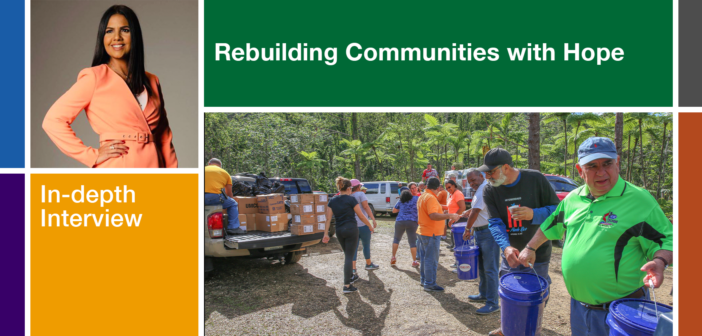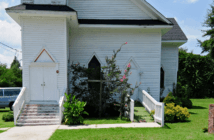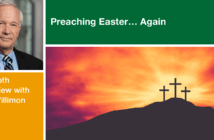How can churches partner with other organizations to effectively and comprehensively meet the needs of their community? Jessica Anschutz of the Lewis Center staff speaks with Glorymar Rivera Báez, executive director of REHACE, about the organization’s work in Puerto Rico providing services to vulnerable populations and rebuilding communities.
Listen to this interview, watch the interview video on YouTube, or continue reading.
Jessica Anschutz: Glorymar, to set the stage for our listeners, I invite you to talk a little bit about the issues that are facing the people of Puerto Rico today.
Glorymar Rivera Báez: Puerto Rico is a territory of the United States but has different struggles: politically, economically, and socially. There are disparities in health care access and benefits as well as disparities in other areas. One of the major challenges that Puerto Rico faces is the economic situation. We have been in an economic recession for more than 10 years, which has put a lot of burden on families.
According to the statistics, somewhere around 50 percent of the population of Puerto Rico lives under poverty conditions. As a result, it is a challenge for families to overcome emergencies, such as atmospheric emergencies, COVID-19, and other situations. Because families are already economically struggling to have access to basics needs and supplies, it is very difficult for families in Puerto Rico to be on their feet once a disaster like Hurricane Maria happens. When Hurricane Maria made landfall in Puerto Rico back in 2017, we were already struggling with this environment that I just mentioned. Those organizations and leaders who are used to working in response to an emergency say that people will overcome or will recover depending on the resources and access to the resources that they have.
The information that I just shared sets the context to better understand why it has been so difficult for communities in Puerto Rico outside of the metropolitan area to get back to normalcy. Puerto Rico is small, geographically speaking. It is 30 by 100 miles, but has a population right now of 30.2 million people. There are more Puerto Rican people on the United States mainland than in Puerto Rico, but there is still a large population located in Puerto Rico. If you visit San Juan, the capital of Puerto Rico, and some of the surrounding metropolitan area, you will have the sense of normalcy because of the tourists and the economic activities. But when you travel further outside the metropolitan area, then you will start seeing a lot of communities living under a lot of stress.
The economic situation, the atmospheric emergencies such as Hurricane Maria, the 2020 earthquakes in the southwest part of the island, and the pandemic affected a lot. Last September we were hit by Hurricane Fiona. So that puts in perspective the multiple situations that we are dealing with and that we have been dealing with for the past years.
Jessica Anschutz: That is a lot to deal with, and any one of those things on its own would certainly be a lot. As you reflect on the impact of Hurricane Maria on Puerto Rico, how have you adapted and changed REHACE’s focus since that time?
Glorymar Rivera Báez: Rehaciendo Comunidades con Esperanza, is the Spanish name for our organization, the nonprofit of the Methodist Church. REHACE was incorporated in 2002, so REHACE has a trajectory of 20 years. But the reality is that before Hurricane Maria, REHACE was seen as a ministry of the church. I say this because sometimes we minimize the work and impact when we use the words that we use, such as ministry, and people tend to see that a ministry is something that people will do as part of their response, their experience, in the church. Even though REHACE was incorporated and had access to a lot of resources because of its status as a nonprofit organization, the impact that it had was primarily to the inside of the church. The work that REHACE did before Hurricane Maria was more related to training, creating awareness, working with volunteers, and providing some access to education through tutoring centers that were in local churches. That was the work that REHACE did on a yearly basis.
After Hurricane Maria, we saw it as a huge opportunity to use REHACE as a platform to have access to external resources, financial resources, and to develop the capacity of REHACE to expand the work and better respond to the emergency. I will say that the first reality check was we had to make decisions at a fast pace when the whole island was under an emergency disaster declaration. The extent of the damage was very present. We didn’t have electricity for many months. There were communities that didn’t have access to water. There were mud slides in the streets.
We were experiencing major damage in different municipalities all over, even in the metropolitan area, so we knew that we needed to do something. In a conversation with the bishop at the time and his leadership team, we saw REHACE as the door to embark in formal conversations with different partners. And we did that fast. We were managing a lot of information. Establishing priorities was very difficult at the time because of how rapidly REHACE expanded. The way I see it is we were babies even though we had existed for many years. We saw ourselves with little potential, but once we shifted the way we saw the organization’s opportunity, then we expanded in a period of eight months. Before Maria, REHACE was working under a deficit. After that, we put everything in order, and we started recruiting people with the funding that we received. We put a lot of effort in capacity building. We put in place a strategic plan to respond to Hurricane Maria, and from there we expanded to the organization that we are now.
So, Hurricane Maria set a before and after for REHACE. And for a period of five years, we have managed a volume of $30 million in direct services. I think that exemplifies in a dramatic way how we saw an organization that was already established and how we saw an opportunity and we took advantage. We said, we need to make some quick decisions. The church has its structure, but because REHACE is a 501(c)(3) organization exempt from federal and local taxes, we were able to get access to Federal funds, local funds, and United Methodist Church funds through UMCOR that helped us expand the work that we did and with amazing results.
Jessica Anschutz: What an inspiring story! And it’s really inspiring to think about the number of lives that REHACE has impacted in this time. Now REHACE has four areas of emphasis. Name those and describe them.
Glorymar Rivera Báez: After 2020, we sat down and evaluated the scope of work and the work that we were doing after Hurricane Maria. We established these four focus areas: response to emergencies including atmospheric, biological, and social emergencies, well-being initiatives, food security, and access to education.
In the response to emergencies area, as part of the response to Hurricane Maria, we developed a comprehensive case management program. We developed that program using UMCOR’s holistic approach to disaster case management, so we have a certified trainer who is our case management director, and we trained the case managers in this holistic approach. We ended the long-term recovery program for Maria last year, and by the end of the program, we served 2,969 families through this comprehensive case management program.
This holistic approach covers a total of 28 met needs, so the case managers help families develop a recovery plan considering the specific needs of the family. The case manager connects the family with resources in their community, and we channel resources that we have and funding that we receive to help that family. In June 2022, we finished our long-term recovery program having served 2,969 families and repaired 1,299 houses of their homes.
The comprehensive case management program is ongoing. We finished the project in response to Hurricane Maria, but we opened the same program to respond to the earthquakes. In January 2023, we opened a program to respond to the families affected by Hurricane Fiona. We have already established a target number of families that we want to serve and the number of houses that we would like to repair. We have 15 collection centers; and the distribution and collection centers operate using church facilities. We train the coordinators, who are lay people that volunteer to provide those services. We set up an infrastructure for the collection centers with protocols and guidelines, which is part of our capacity building effort.
In the well-being area, we developed a program that equips people to cope with the different crises. We provide psychoeducational workshops and group therapy sessions for affected families. Our purpose is to provide the skills and the knowledge that people need to better respond to the emotional distress in the different crises that they are experiencing. We work with children, with older adults, and with the community of immigrants. Most of the immigrants come from the Dominican Republic or Haiti and are in the metropolitan area. For these ministries and projects, we partner with local churches and other nonprofit organizations that are present and are working in these areas.
For food security, we have partnered with the Food Bank of Puerto Rico, the Council of Churches, and also with private organizations that provide food assistance. We distribute food vouchers throughout the year and grocery bags to families on a mass scale. we distribute large amounts of food.
For access in education, we have four tutoring centers where we provide tutoring services. We have strengthened the tutoring center services with psychosocial curriculum. We also provide skills workshops for the children, so they have the skills to better respond and not be in a vulnerable situation. Those are the four areas and some of the projects that we have in each area.
Jessica Anschutz: I really appreciate the comprehensive approach that you take to addressing the needs of your community. When I look at a lot of congregations’ responses to poverty and disaster relief, they tend to focus on the immediate response to the emergency, food safety, and access to education. I think we often forget about the wellness piece. Can you share some more about what that wellness piece looks like on the ground?
Glorymar Rivera Báez: Yes. When we expanded our projects after Hurricane Maria, we were focused primarily on the comprehensive case management, providing direct assistance, and later we developed the construction unit. We put a lot of emphasis in those areas. After the earthquakes, one of the things that we immediately noticed that there weren’t a lot of structures damaged after the earthquakes, but people were staying outside of their houses. People relocated to sleep in tents. They didn’t want to get back to their homes.
What we saw, what we immediately experienced, was a lack of coping strategies. Well-being and mental health were the most affected aspects after the earthquakes. When we had conversations with other nonprofit organizations and disaster response agencies, everybody across the board said that what the people need is emotional care, spiritual care. That was very, very evident across the island.
The earthquakes took place in the southwest part of the island. But even in the metropolitan area, people were having trouble sleeping and in their interpersonal relationships and all of that. So, we wondered what should we do to respond? We didn’t have the infrastructure to help families with their repairs because the houses in Puerto Rico, most of the houses, are concrete. It is very expensive and very hard to complete construction with concrete.
So, we asked: what can we do to help families right away? Since our case managers are mostly either psychologists or social workers, we made a shift in their task, and we put together brigades of emotional care, and we sent those brigades to the communities where people were sleeping in tents and where people were in small clusters or families and communities. We started deploying emotional care brigades and then sat down to put together a more formal approach to respond in the long run.
That’s how the RED program — Resiliencia Emocional ante un Disaster, an emotional resilience program — was developed. We set up a model that incorporates the emotional care with evidence-based strategies to deal and cope, to strengthen how to deal with your emotions, always recognizing that there are no good or bad emotions. There are emotions, and we need to recognize them. The key component is how we deal with the emotions, how we translate or transform those emotions into good behavior or behavior that will have good results in our decision making, etc.
We incorporated evidence-based components from the psychology area and spiritual care. For the therapy group sessions, the psychologist will partner with the pastor in some of the sessions, so families or the participants will have both components — the mental aspect and the spiritual care. Those therapy groups have five sessions, so this is fairly small; it is not a long-term therapeutic process. For people that need to receive individual care, we will refer. We establish partnerships with different organizations that work specifically in that area. The other component that we developed was two-hour or a one-hour workshops in which we cover information about how we deal with emotions. How can we cope in distress if we are in distress or in a crisis? How can we cope, if we are experiencing an emergency such as an earthquake or a hurricane, etc.?
The important thing is these skills and strategies that we provide to the participants are strategies that they can use in any other context. If they are experiencing a family crisis because they lost their job, they can use those strategies. If they are experiencing a marital or some type of crisis, they can put that in place. So, I think this is one of the areas that is a huge opportunity for churches to partner with programs in the mental health area. And there are good programs in different areas. If you pay attention to the statistics in different places, in different states, there is a big mental health crisis. We have been working at a smaller scale, but the feedback that we have received is amazing. People really appreciated that type of intervention.
Jessica Anschutz: Thank you so much, Glorymar, for highlighting the mental health crisis and for sharing just a little bit about how you all are working to respond to that. I hope that it can be an inspiration to our listeners. Our time together is drawing to a close, yet I feel like you have so much to offer and to share with our listeners. As we close our time together today, I invite you to reflect on any words of wisdom you may have for church leaders as they seek to address the needs of their communities.
Glorymar Rivera Báez: Jessica, this has been my experience as a person that grew up in the church with my father as a pastor. I have been working with the church for many years, and I think that we need to adapt to the new realities of the world that we are living in. Sometimes people are afraid, and they think that by saying we need to adapt means that we need to distance ourselves from the words of Jesus and the evangelical approach. That’s not what I feel. When I say that we need to adapt, I mean that we need to make sure that the church is relevant to the people. If the community, the people, don’t feel that the church is relevant to their needs, to their lives, what’s the purpose in attending church?
Sometimes I see that the church puts a lot of attention into the way we do the worship — the music and all those types of experiences. At the end of the day, I believe that people really need us to equip them with the skills and resources to be a better dad, a better mom, so they can be a better professional at their workplace, so they can better respond to different crises. I think that the church has a huge opportunity to transform the way we do church, the way that we behave. We need to be relevant to the times and to the people around us. Otherwise, the church will no longer be a place that people will look to. I think that we have a huge opportunity to reflect on that and to see in which other ways we can serve and can exemplify Jesus’ words and love and what Jesus has asked us to do daily.
Jessica Anschutz: Thank you so much, Glorymar, for your time today, for your work, and for your ministry. May God bless and keep you.
Glorymar Rivera Báez: Thank you, Jessica. I feel blessed being part of these podcasts, so thank you so much.
Related Resources
- 9 Strategies for Meeting People and Learning Their Needs by Elizabeth Mae Magill
- 6 Ways to Turn Your Church Inside-Out by Ben Ingebretson
- Creatively Engaging Your Community While Remaining True to Who You Are by Paul Nixon
- How One-to-One Conversations Reintroduced a Church to its Neighbors by Travis Norvell






